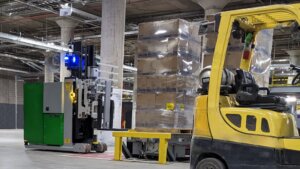Two of our palletizer lines are not operating consistently, and they cannot be integrated with our AGVs. We need help integrating our systems to reduce manual operations.
A paper products manufacturer with over 500 locations around the globe is on a mission to improve safety, quality, and reliability. To achieve their goals, they are committed to transforming their manufacturing equipment and processes across the enterprise, including integration of AGVs (Automated Guided Vehicles) at all their converting plants.
The Situation
 With a looming AGV integration on the horizon, one of the converting plants in the southern U.S. reached out to LSI for help with their palletizer lines. Two of the lines were not like the others – they all had similar equipment and configurations, but the two that were installed and integrated last had inoperable printers and were missing robust traffic logic programming. Although the previous integrator had made an attempt at duplicating the programming from the other five palletizer lines, it didn’t work. The only way to make the two problem palletizer lines work was for the operators to print labels manually, apply them, and scan the barcodes. This approach significantly slowed down the two lines and prevented integration with the AGVs.
With a looming AGV integration on the horizon, one of the converting plants in the southern U.S. reached out to LSI for help with their palletizer lines. Two of the lines were not like the others – they all had similar equipment and configurations, but the two that were installed and integrated last had inoperable printers and were missing robust traffic logic programming. Although the previous integrator had made an attempt at duplicating the programming from the other five palletizer lines, it didn’t work. The only way to make the two problem palletizer lines work was for the operators to print labels manually, apply them, and scan the barcodes. This approach significantly slowed down the two lines and prevented integration with the AGVs.
The Solution
On the first on-site engagement, LSI’s Murray, KY office personnel evaluated the controls on the problem lines and compared them with the “model” palletizer line before developing a controls narrative document. The controls narrative was not only important for LSI to determine the best solution but it’s also valuable for client engineers, operators, and maintenance personnel as it now serves as a reference document for understanding, operating, troubleshooting, and maintaining the system.
For perspective, the system contained multiple control systems and communication protocols, including Rockwell Automation ControlLogix, SLC 500, Markem Imaje (printer) proprietary controls (interfaced through a third-party serial gateway), DeviceNet, and Ethernet/IP.
During the evaluation, LSI also determined that the existing Markem Imaje Printers were beyond repair, so these were replaced and re-integrated. Following this visit, the AGV manufacturer began to integrate the operating palletizer lines with the AGVs (LSI was not initially involved in AGV integration).
For the next on-site engagement, LSI deployed an engineer with extensive controls experience and a strong mechanical background. This engineer had previously worked on projects at one of the world’s largest shipping couriers, and he brought domain experience in processes related to labeling and package tracking. Using the controls narrative previously developed, he jumped in and started reconfiguring the palletizer lines to be functionally the same and “integration-ready” for the AGVs. He identified several ways to improve tracking and ensure seamless information flow for the palletizer outfeed conveyor load points. Working closely with the line technicians and operators, LSI’s engineer was also able to customize the system (updating HMIs and alarms) to provide better clarity, simplify, and streamline their interface rather than live with the system as delivered by the OEM.
 With the client now realizing the benefits of having an experienced controls engineer on-site, the focus shifted to abnormal condition handling with the AGVs and general product flow. Here’s an example of abnormal condition handling: 24 boxes of paper towels accumulate on the infeed of the palletizer line, but the order only requires 20. The remaining four boxes are passed through as a partial pallet. The operator then pulls the partial off the line until more boxes are passed through to create a full pallet. Prior to LSI’s involvement, the operator would process these partial pallets, create labels in a bypass mode, and set the pallet aside for disposition later. This was very time-consuming and problematic. To address this, LSI developed a new interface for the operators to use that allowed them to enter the information quickly, print new labels, and add the finished pallet into the line so that it was tracked in the system as if it had just come off the palletizer.
With the client now realizing the benefits of having an experienced controls engineer on-site, the focus shifted to abnormal condition handling with the AGVs and general product flow. Here’s an example of abnormal condition handling: 24 boxes of paper towels accumulate on the infeed of the palletizer line, but the order only requires 20. The remaining four boxes are passed through as a partial pallet. The operator then pulls the partial off the line until more boxes are passed through to create a full pallet. Prior to LSI’s involvement, the operator would process these partial pallets, create labels in a bypass mode, and set the pallet aside for disposition later. This was very time-consuming and problematic. To address this, LSI developed a new interface for the operators to use that allowed them to enter the information quickly, print new labels, and add the finished pallet into the line so that it was tracked in the system as if it had just come off the palletizer.
The Results
With LSI’s help, the client’s seven palletizer lines are now running consistently and fully integrated with the AGVs. Abnormal condition handling is streamlined, which allows the operator to handle partial pallets more efficiently, with fewer manual steps. The line technicians and operators had a voice in the improvements, and now the HMIs are user-friendly, alarms are meaningful, and overall programming is more robust.
As a result of this successful engagement, the client is planning to involve LSI in other converting plants as the AGVs are brought online.
LSI Listened
LSI listened, and then our team went to work developing a controls narrative that became the foundation for understanding and solving the client’s persistent palletizer integration issues. By working closely with the client team, progress and priorities were easily communicated, enabling efficient use of time on-site.
